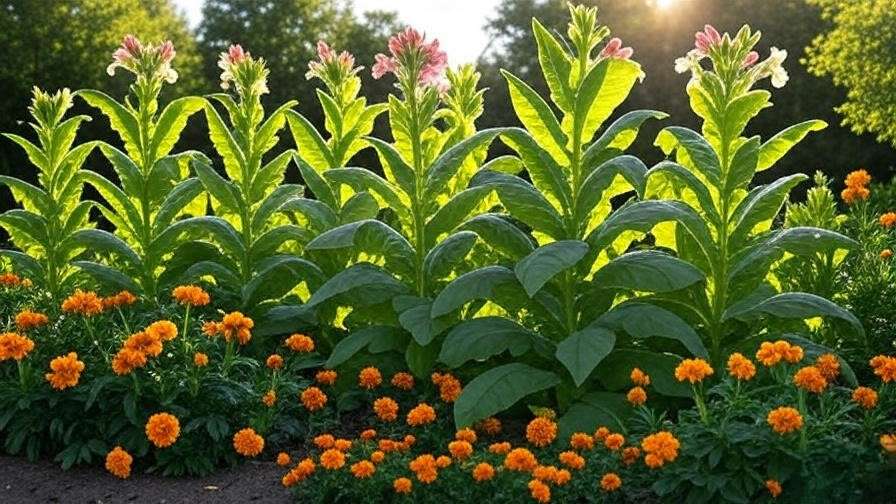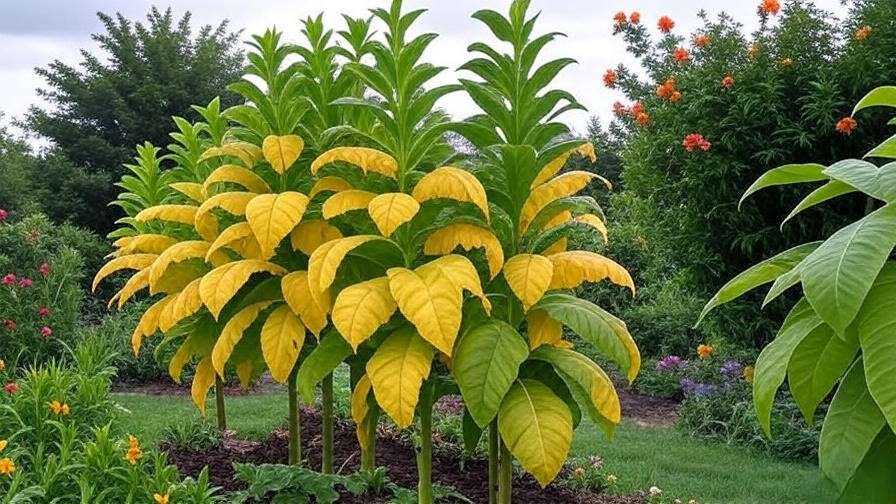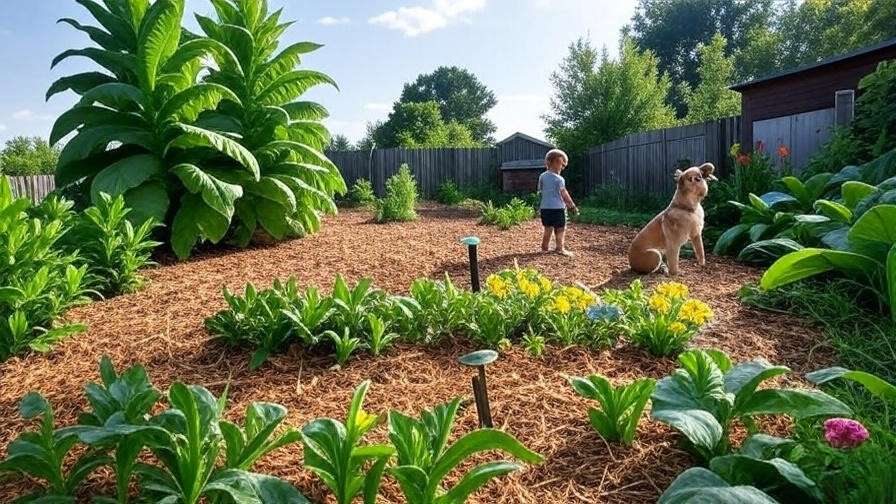Picture this: a warm summer evening, your garden aglow with delicate, trumpet-shaped flowers that release a sweet, jasmine-like fragrance. This is the magic of the tobacco tree (Nicotiana spp.), a stunning ornamental plant that transforms any outdoor space into a pollinator’s paradise. Whether you’re a novice gardener or a seasoned green thumb, growing a tobacco tree offers a rewarding way to add beauty and biodiversity to your landscape. But how do you ensure vibrant blooms and healthy growth? This comprehensive guide unlocks the secrets to cultivating thriving tobacco trees, addressing common challenges and empowering you to create a flourishing garden display. 🌸
With their elegant flowers and low-maintenance charm, tobacco trees are perfect for gardeners seeking both aesthetic appeal and ecological benefits. In this article, we’ll cover everything from planting to pest control, drawing on expert horticultural knowledge and practical tips to help you succeed. Let’s dive into the world of Nicotiana and discover how to make your tobacco tree thrive!
H2: What Is a Tobacco Tree? Understanding Nicotiana 🌸
H3: Botanical Background and Varieties
The tobacco tree, scientifically known as Nicotiana, belongs to the Solanaceae family, which includes tomatoes and potatoes. Unlike its commercial cousin used in tobacco production, ornamental Nicotiana species like Nicotiana sylvestris (flowering tobacco) and Nicotiana alata (jasmine tobacco) are prized for their stunning blooms and fragrance. These plants typically grow 3–5 feet tall, with lush green foliage and star-shaped flowers in shades of white, pink, or red. N. sylvestris boasts long, tubular blooms, while N. alata offers a wider color palette and a sweet scent that intensifies at dusk. 🌙
Each variety has unique traits, making them versatile for different garden styles. For example, N. sylvestris suits bold, dramatic borders, while N. alata shines in containers or cottage gardens. Understanding these differences helps you choose the right variety for your space.

H3: Historical and Cultural Significance
Tobacco plants have a rich history, originally cultivated by indigenous peoples in the Americas for ceremonial and medicinal purposes. Ornamental tobacco trees gained popularity in European gardens during the 19th century, valued for their beauty and evening fragrance. Today, they’re celebrated for adding a touch of nostalgia and elegance to modern landscapes. Their ability to attract pollinators also aligns with the growing interest in sustainable gardening. 🌍
Expert Insight: “Nicotiana is a gardener’s gem,” says Dr. Emily Harper, a horticulturist at the Royal Horticultural Society. “Its evening blooms not only enhance garden aesthetics but also support nocturnal pollinators, making it a must-have for eco-conscious gardeners.”
H2: Benefits of Growing a Tobacco Tree 🌼
H3: Aesthetic Appeal
Tobacco trees are a visual delight, with their graceful flowers and lush foliage. Their trumpet-shaped blooms create a striking focal point in any garden, especially when planted in clusters. The evening fragrance of varieties like N. alata adds a sensory layer, making your garden a relaxing retreat after sunset. These plants are ideal for borders, mixed beds, or as standalone features in small spaces.

H3: Ecological Benefits
Beyond beauty, tobacco trees are pollinator magnets. Their nectar-rich flowers attract hummingbirds, bees, and moths, boosting garden biodiversity. By planting tobacco trees, you contribute to a healthier ecosystem, supporting pollinators vital to food production and environmental balance. 🌺
H3: Low-Maintenance Charm
For busy gardeners, tobacco trees are a dream. They require minimal upkeep once established, thriving in a range of conditions with basic care. Their resilience makes them suitable for both novice and experienced gardeners.
Tip: Tobacco trees shine in cottage gardens, moon gardens (designed for evening enjoyment), or as accents in modern minimalist landscapes. Pair them with soft-textured plants like lavender or cosmos for a cohesive look.
H2: How to Plant a Tobacco Tree: Step-by-Step Guide 🌱
H3: Choosing the Right Location
Tobacco trees thrive in USDA hardiness zones 8–11, though they can be grown as annuals in cooler climates. They prefer full sun (6–8 hours daily) but tolerate partial shade, especially in hotter regions. Well-draining, fertile loam with a pH of 6.0–7.0 is ideal. Test your soil before planting to ensure optimal conditions. Avoid heavy clay or waterlogged areas, as these can stunt growth.

H3: Starting from Seeds or Seedlings
Tobacco trees are easy to grow from seeds, which are tiny and require careful handling. Start seeds indoors 6–8 weeks before the last frost:
- Fill a seed tray with a seed-starting mix.
- Sprinkle seeds lightly on the surface (don’t bury them—they need light to germinate).
- Mist gently and cover with a clear lid to retain humidity.
- Place in a warm spot (70–75°F). Seedlings emerge in 7–14 days.
Transplant seedlings outdoors after the frost risk passes, spacing them 12–18 inches apart. Alternatively, purchase nursery-grown seedlings for faster results. Harden off plants by gradually exposing them to outdoor conditions over a week.
H3: Timing and Seasonal Considerations
Plant in spring or early summer for best results. In warmer climates (zones 9–11), fall planting is also viable. Check your local frost dates to time planting accurately. In cooler regions, treat tobacco trees as annuals or overwinter them indoors in pots.
Example: Planting Checklist
- Test soil pH and amend if needed.
- Choose a sunny, well-draining spot.
- Start seeds indoors or buy healthy seedlings.
- Transplant after the last frost, spacing plants properly.
H2: Essential Care Tips for a Healthy Tobacco Tree 🌞
H3: Watering Needs
Tobacco trees need consistent moisture, especially during establishment. Water deeply once or twice a week, ensuring the top 1–2 inches of soil remain moist but not soggy. Overwatering can lead to root rot, while underwatering causes wilting or sparse blooms. Check for signs like yellowing leaves (overwatering) or drooping stems (underwatering) and adjust accordingly. In hot climates, mulch around the base to retain moisture.
H3: Fertilizing for Vibrant Blooms
Feed tobacco trees with a balanced 10-10-10 fertilizer every 4–6 weeks during the growing season (spring to early fall). Alternatively, use a bloom-boosting fertilizer (e.g., 5-10-10) to encourage more flowers. Apply according to package instructions, avoiding over-fertilization, which can lead to excessive foliage at the expense of blooms. Organic options like compost tea also work well.
H3: Pruning and Deadheading
To keep your tobacco tree looking tidy and blooming profusely, deadhead spent flowers weekly. Snip just above a leaf node to encourage new blooms. For bushier growth, pinch back young plants when they reach 6–8 inches tall. Remove any yellowing or damaged leaves to maintain plant health and improve air circulation.
Expert Tip: Here’s a quick care summary:
| Aspect | Requirement |
|---|---|
| Water | 1–2 times/week, keep soil moist |
| Light | Full sun to partial shade |
| Soil | Well-draining, pH 6.0–7.0 |
| Fertilizer | Balanced 10-10-10 every 4–6 weeks |
H2: Common Challenges and How to Overcome Them 🐞
H3: Pest Management
Tobacco trees are generally resilient, but they can attract pests like aphids, whiteflies, and spider mites. These tiny invaders can sap plant vigor, causing curled leaves or stunted growth. To manage pests organically:
- Spray with neem oil: Dilute according to instructions and apply in the evening to avoid leaf burn.
- Use insecticidal soap: Target affected areas, ensuring thorough coverage.
- Introduce beneficial insects: Ladybugs and lacewings are natural predators of aphids.
Companion planting with marigolds or garlic can deter pests naturally. Regularly inspect your plants, especially under leaves, to catch infestations early.

H3: Disease Prevention
Common diseases affecting tobacco trees include powdery mildew and root rot. Powdery mildew appears as white, powdery spots on leaves, often in humid conditions. To prevent it:
- Ensure proper spacing (12–18 inches) for air circulation.
- Water at the base, not overhead, to keep foliage dry.
- Apply a fungicide like sulfur if symptoms persist.
Root rot, caused by overwatering or poor drainage, can be avoided by using well-draining soil and monitoring watering habits. If you notice wilting despite moist soil, check roots for dark, mushy sections and trim affected areas.
H3: Environmental Stress
Tobacco trees may struggle in extreme heat, drought, or poor soil. Signs of stress include drooping leaves, sparse blooms, or yellowing foliage. To combat these:
- Heat stress: Provide afternoon shade in hot climates or use mulch to cool roots.
- Drought: Increase watering frequency during dry spells, ensuring deep soil penetration.
- Poor soil: Amend with compost or organic matter to boost fertility.
Regular monitoring and quick action can keep your tobacco tree thriving.
Case Study: Last summer, gardener Sarah noticed her Nicotiana sylvestris wilting despite regular watering. After checking the soil, she discovered root rot due to poor drainage. By repotting the plant in a well-draining mix and adjusting her watering schedule, Sarah revived her tobacco tree, which bloomed vibrantly by fall. 🌸
H2: Propagating Tobacco Trees: Expand Your Garden 🌿
H3: Collecting and Storing Seeds
Tobacco trees produce tiny seeds in small pods after flowering. To collect them:
- Wait until pods turn brown and dry on the plant.
- Gently crush pods to release seeds, then sift to remove debris.
- Store seeds in a labeled, airtight container in a cool, dry place (e.g., a refrigerator).
Seeds remain viable for 2–3 years if stored properly. Sow them the following spring for new plants.
H3: Dividing or Transplanting
While tobacco trees are typically grown as annuals, perennial varieties in warmer climates can be divided or transplanted:
- Dividing: In spring, dig up mature plants, separate healthy root clumps, and replant immediately.
- Transplanting: Move young plants to new locations, ensuring minimal root disturbance. Water thoroughly after transplanting to reduce shock.
Use a root stimulant to encourage establishment.
Tip: Save seeds sustainably by collecting only what you need and leaving some pods for natural reseeding, supporting local pollinators.
H2: Creative Ways to Use Tobacco Trees in Your Garden 🎨
H3: Landscaping Ideas
Tobacco trees are versatile in garden design. Their height and vibrant blooms make them ideal for:
- Mixed borders: Pair with shorter plants like zinnias or cosmos for a layered effect.
- Focal points: Plant a cluster of N. sylvestris in the center of a circular bed for drama.
- Moon gardens: Their white flowers and evening fragrance glow under moonlight, creating a magical ambiance.
Combine with complementary plants like lavender, salvia, or phlox for a cohesive look.

H3: Container Gardening
Tobacco trees thrive in pots, making them perfect for patios or balconies. Choose a container at least 12–16 inches deep with drainage holes. Use a high-quality potting mix with added perlite for drainage. Place in a sunny spot and water regularly, as containers dry out faster than garden beds. N. alata varieties, with their compact growth, are especially suited for pots.
Inspiration: Imagine a cozy patio with a trio of potted tobacco trees, their flowers glowing in the evening light, surrounded by trailing petunias and soft candlelight. 🌙
H2: Frequently Asked Questions About Tobacco Trees ❓
- Are tobacco trees toxic to pets or humans?
Yes, Nicotiana contains nicotine, which is toxic if ingested. Keep plants away from pets and children, and wear gloves when handling to avoid skin irritation. - Can tobacco trees grow indoors?
While possible, indoor growth requires bright light (e.g., a south-facing window or grow lights) and good ventilation. They’re better suited to outdoor gardens. - How long do tobacco trees bloom?
With proper care, they bloom from early summer to first frost, often 3–4 months. Deadheading extends the season. - What’s the difference between Nicotiana and commercial tobacco?
Ornamental Nicotiana is bred for beauty and fragrance, while commercial tobacco (N. tabacum) is grown for its leaves and has less aesthetic appeal.
Expert Insight: These answers are informed by research from the University of California’s Cooperative Extension, ensuring accuracy and reliability.
H2: Environmental and Safety Considerations ⚠️
H3: Toxicity Awareness
The nicotine in tobacco trees poses risks if ingested, potentially causing nausea or dizziness in humans and pets. To ensure safety:
- Plant in areas inaccessible to pets or young children.
- Label plants in shared gardens to warn others.
- Wash hands after handling foliage or seeds.
Educating yourself and others about these risks fosters a safe gardening environment.

H3: Sustainable Gardening Practices
Tobacco trees align with eco-friendly gardening:
- Organic care: Use compost, neem oil, or companion planting to minimize chemical use.
- Pollinator support: Their nectar-rich flowers boost biodiversity.
- Water conservation: Mulch and water wisely to reduce waste.
By prioritizing sustainability, you create a garden that’s both beautiful and environmentally responsible.
Tip: Use this checklist for safe, eco-friendly tobacco tree care:
- Plant away from pet/child access.
- Use organic pest control methods.
- Mulch to conserve water and enrich soil.
H2: Conclusion: Grow Your Own Stunning Tobacco Tree 🌸
Growing a tobacco tree is a rewarding journey, blending beauty, fragrance, and ecological benefits. With their vibrant blooms and low-maintenance nature, Nicotiana plants are a perfect addition to any garden. By following this guide—choosing the right location, providing proper care, and addressing challenges—you’ll enjoy a thriving tobacco tree that dazzles from summer to fall. Start planting today and watch your garden come alive with color and life!













